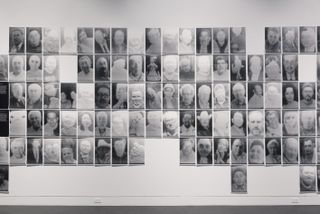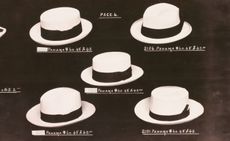Rafael Lozano-Hemmer’s robotic sand installation honours lives lost to Covid-19
At the Brooklyn Museum, Rafael Lozano-Hemmer’s participatory work, A Crack in the Hourglass, An Ongoing Covid-19 Memorial, offers space to collectively honour and grieve victims of the pandemic

Since it emerged, the Covid-19 pandemic has claimed the lives of more than five million people globally. The loss is extraordinary, and the agony has been exacerbated by restrictions on collective mourning with family and friends denied physical participation in funerary rites and rituals for their loved ones. In 2020, Mexican-Canadian media artist Rafael Lozano-Hemmer responded with a virtual memorial whereby bereaved family and friends could create individual homages.
A Crack in the Hourglass was first commissioned by the Museo Universitario Arte Contemporáneo in Mexico City and has been taking place virtually since November 2020. The project was staged as an ephemeral ‘anti-monument’; a space for catharsis and an impassioned lament that depends entirely on the participation of others.

Raphael Lozano-Hemmer, A Crack in the Hourglass, An Ongoing Covid-19 Memorial, at the Brooklyn Museum
Through ephemeral portraits made from hourglass sand, the installation and its online platform provide communities with space to collectively mourn and honour those lost to Covid-19 in New York City – which has seen some of the highest numbers of pandemic-related deaths in the United States – and worldwide.
The Brooklyn Museum is now presenting the first physical version of the work. Participants are invited to submit photographs of their loved ones who have died from Covid-19 through the project’s online platform, accompanied by a personal dedication, and watch in person or via live stream as a robotic arm deposits grains of sand onto a black surface to recreate the image. Once each portrait is formed, it is digitally archived and gradually erased by gravity. The same sand is then recycled into the next portrait forming an infinite number of memorials.
‘This project is designed for mourning our losses at a time when we have been socially distant and denied proximity to those affected. The piece also represents continuity, as the same sand is used to make an endless number of unique portraits,’ says Lozano-Hemmer, who is known for provocative indoor and outdoor art installations on the intersection of technology, architecture, performance, and public art. ‘I am very eager to see how the project is received in New York City, an epicentre of the pandemic, and am thankful to the Brooklyn Museum for bringing it to the United States.’

Raphael Lozano-Hemmer at the Brooklyn Museum. 'A Crack in the Hourglass, An Ongoing Covid-19 Memorial', until 26 June 2022.


Top and above: installation view of Raphael Lozano-Hemmer, A Crack in the Hourglass, An Ongoing Covid-19 Memorial, at the Brooklyn Museum
INFORMATION
Raphael Lozano-Hemmer, A Crack in the Hourglass, An Ongoing Covid-19 Memorial, until 26 June 2022, the Brooklyn Museum, brooklynmuseum.org
Wallpaper* Newsletter
Receive our daily digest of inspiration, escapism and design stories from around the world direct to your inbox
Harriet Lloyd-Smith was the Arts Editor of Wallpaper*, responsible for the art pages across digital and print, including profiles, exhibition reviews, and contemporary art collaborations. She started at Wallpaper* in 2017 and has written for leading contemporary art publications, auction houses and arts charities, and lectured on review writing and art journalism. When she’s not writing about art, she’s making her own.
-
 Aesop’s Salone del Mobile 2024 installations in Milan are multisensory experiences
Aesop’s Salone del Mobile 2024 installations in Milan are multisensory experiencesAesop has partnered with Salone del Mobile to launch a series of installations across Milan, tapping into sight, touch, taste, and scent
By Hannah Tindle Published
-
 Dial into the Boring Phone and more smartphone alternatives
Dial into the Boring Phone and more smartphone alternativesFrom the deliberately dull new Boring Phone to Honor’s latest hook-up with Porsche, a host of new devices that do the phone thing slightly differently
By Jonathan Bell Published
-
 Berlinde De Bruyckere’s angels without faces touch down in Venice church
Berlinde De Bruyckere’s angels without faces touch down in Venice churchBelgian artist Berlinde De Bruyckere’s recent archangel sculptures occupy the 16th-century white marble Abbazia di San Giorgio Maggiore for the Venice Biennale 2024
By Osman Can Yerebakan Published
-
 The Met’s ‘The Real Thing: Unpacking Product Photography’ dissects the avant-garde in early advertising
The Met’s ‘The Real Thing: Unpacking Product Photography’ dissects the avant-garde in early advertisingA new exhibition at The Metropolitan Museum of Art in New York explores the role of product photography and advertising in shaping the visual language of modernism
By Zoe Whitfield Published
-
 Tony Notarberardino’s Chelsea Hotel Portraits preserve a slice of bygone New York life
Tony Notarberardino’s Chelsea Hotel Portraits preserve a slice of bygone New York life‘Tony Notarberardino: Chelsea Hotel Portraits, 1994-2010’, on show at New York’s ACA Galleries, is the photographer’s ode to the storied hotel he calls home and its eclectic clientele
By Hannah Silver Published
-
 ‘LA Gun Club’: artist Jane Hilton on who’s shooting who
‘LA Gun Club’: artist Jane Hilton on who’s shooting who‘LA Gun Club’, an exhibition by Jane Hilton at New York’s Palo Gallery, explores American gun culture through a study of targets and shooters
By Hannah Silver Published
-
 Detroit Institute of Arts celebrates Black cinema
Detroit Institute of Arts celebrates Black cinema‘Regeneration: Black Cinema 1898-1971’ at the Detroit Institute of Arts (DIA) brings lost or forgotten films, filmmakers and performers to a contemporary audience
By Anne Soward Published
-
 BLUM marks 30 years of Japanese contemporary art in America
BLUM marks 30 years of Japanese contemporary art in AmericaBLUM will take ‘Thirty Years: Written with a Splash of Blood’ to its New York space in September 2024, continuing its celebration of Japanese contemporary art in America
By Timothy Anscombe-Bell Published
-
 Todd Gray’s sculptural photography collages defy dimension, linearity and narrative
Todd Gray’s sculptural photography collages defy dimension, linearity and narrativeIn Todd Gray’s New York exhibition, he revisits his 40-year archive, fragmented into elaborated frames that open doors for new readings
By Osman Can Yerebakan Published
-
 Frieze LA 2024 guide: the art, gossip and buzz
Frieze LA 2024 guide: the art, gossip and buzzOur Frieze LA 2024 guide includes everything you need to know and see in and around the fair
By Renée Reizman Published
-
 New York artist Christopher Astley showcases an alternative natural world
New York artist Christopher Astley showcases an alternative natural worldAt Martos Gallery in New York, Christopher Astley’s paintings evoke an alternative natural world and the chaos of warfare (until 16 March 2024)
By Tianna Williams Published